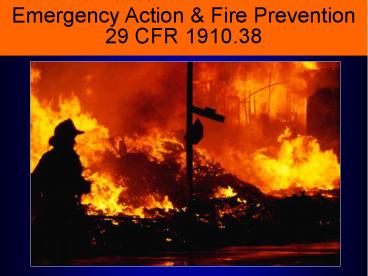Emergency Action - PowerPoint PPT Presentation
Title:
Emergency Action
Description:
Emergency Action & Fire Prevention 29 CFR 1910.38 Are You Prepared? How would you react to a fire alarm at work? Would you know your role if there was a major ... – PowerPoint PPT presentation
Number of Views:236
Avg rating:3.0/5.0
Title: Emergency Action
1
Emergency Action Fire Prevention 29 CFR 1910.38
2
Are You Prepared?
- How would you react to a fire alarm at work?
- Would you know your role if there was a major
chemical spill? - What if an earthquake or hurricane struck our
community?
3
Goals
- Potential hazards
- Emergency response
- Evacuation
- Quiz
4
Fire Hazards and Prevention
- Flammable/combustible liquids
- Combustible solids
- Machine overheating/electrical malfunction
- Welding and torch cutting
- Smoking
5
Flammable Chemicals
- Dont smoke
- Proper storage
- Proper dispensing
- Read labels and MSDS
- Spill response
6
Electrical Fire Hazards
- Overloaded electrical systems
- Frayed or damaged wiring
- Defective machinery or power tools
7
Housekeeping
- Control flammable and combustible materials so
they do not contribute to the ignition or
expansion of a fire - Keep exits clear and maintain the accessibility
to fire response equipment
8
Chemical Spill Hazards
- Chemical types and locations
- Spotting a leak or spill
- Specific chemical hazards
9
Natural Disasters
- Earthquake
- Flooding
- Tornado/hurricane
10
Goals
- Potential hazards
- Emergency response
- Evacuation
- Quiz
11
Fire Response
- Notification or alarm
- Retrieve a fire extinguisher
- Assess the situation
- Call for outside emergency assistance if
necessary - If fighting a fire, continually evaluate for the
necessity of evacuation
12
Alarms
- Yell for help
- Main alarm system
- Backup alarm
- Fire suppression system will automatically signal
an alarm to the fire department
13
Emergency Numbers
- Fire Department
- Police Department
- Ambulance
- Medical Clinic
- Hospital
14
Extinguishing Equipment
- Portable extinguisher
- Fire hose
- Fire suppression systems
15
Extinguisher Types
- A - For combustibles such as trash, wood, or
paper - B - For flammable liquids or gases
- C - For electrical fires
- D - For combustible metals like magnesium
16
Extinguisher Use
- Pull the pin
- Aim at the base of the fire
- Squeeze the trigger
- Sweep back and forth
17
Fire Fighting Dangers
- Flame
- Heat
- Smoke
- Toxic vapors
- Suffocation
- Explosions
18
Chemical Spills
- Evacuate the area
- Notify a supervisor or the emergency response
team - Remove ignition sources (if safe to do so)
19
Goals
- Potential hazards
- Emergency response
- Evacuation
- Quiz
20
Evacuation Assignments
- Evacuation coordinators
- Head count
- Medical
- Shut down equipment
- Fire/chemical responders
- Evacuate
21
Evacuation Preparedness
- Become familiar with nearest exit and keep it
clear - Participate in drills and provide feedback
- Become familiar with evacuation coordinators and
head-count personnel
22
Evacuation Procedures
- Recognize the evacuation signal and listen for
instructions - Shut down equipment using the emergency stop
- Go directly to the nearest safe exit
- Proceed to the assembly area.
23
Goals
- Potential hazards
- Emergency response
- Evacuation
- Quiz
24
Summary
- Understand how to prevent emergencies
- Understand emergency response
- Only use fire-fighting equipment if trained
- Know your role in an evacuation
- Apply this information (also applies at home)
- Ask your supervisor
25
Quiz
- 1. Housekeeping is only important because it
keeps the facility looking nice. True or False - 2. The class A extinguisher is used for putting
out combustible metal fires. True or False - 3. Name two potential fire hazards in your
workspace __________________ and
__________________. - 4. If someone is on fire, it is best to use an
extinguisher on the person. True or False - 5. Describe the first two things you should do if
you spot a fire ______________ and
______________.
26
Quiz (cont.)
- 6. What is the most dangerous habit to have when
working with flammable chemicals? - 7. To use a fire extinguisher P ______________,
A__________, S___________, S___________. - 8. Name the evacuation coordinator and head-count
person for your department. - 9. Prior to evacuating out the nearest exit, you
should _______________________________. - 10. Which type of natural disaster is most likely
to strike your community, and how are you and
your company prepared for it?
27
Quiz Answers
- 1. False. Housekeeping prevents accumulation of
materials that may ignite or contribute to a
fire. - 2. False. Class A is for combustibles like wood
or paper. For combustible metals use class D. - 3. Flammable liquids, piles of rags or boxes,
poor smoking habits, frayed electrical cords,
etc. - 4. False. Help the person stop, drop, and roll.
- 5. Notify someone, such as a supervisor, and
retrieve fire equipment, such as an extinguisher.
28
Quiz Answers (cont.)
- 6. Smoking is a very dangerous habit when working
with flammable chemicals. - 7. Pull the pin, Aim at the base of the fire,
Squeeze the trigger, Sweep back and forth. - 8. The evacuation coordinator and headcount
person for each department are defined in the
emergency action plan. - 9. Shut down equipment using the emergency stop
button. - 10. Discuss company and personal plans for
responding to natural disasters in your area.































